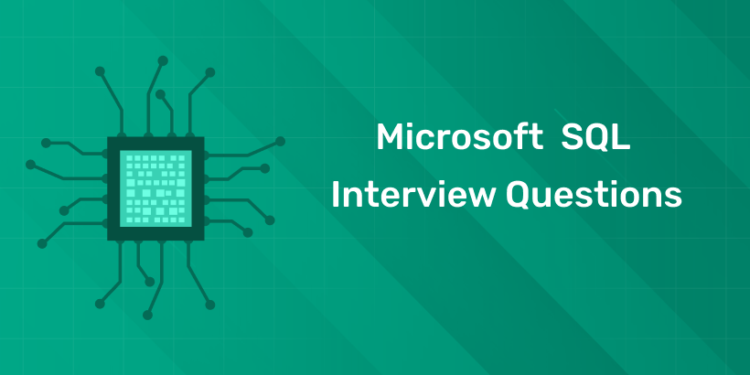Table of Contents
Introduction
Getting ready for a Microsoft SQL interview can be scary but its a must for anyone who wants to join one of the best tech companies in the world. Microsoft is known for its tough interview process especially for data management and SQL (Structured Query Language) related roles. SQL is not just about knowing the syntax; its about knowing how to manipulate data, optimize queries and solve real world problems. In this blog we will see Microsoft SQL interview questions, why you should join Microsoft, interview preparation tips and more.
Why Join Microsoft?
1: Which of the following algorithms is most suitable for classification tasks?
Microsoft is a global technology leader offering unlimited growth, learning and career opportunities. Working at Microsoft means being part of a company that is at the cutting edge of innovation, from cloud to artificial intelligence. Here are some reasons why joining Microsoft could be a game changer for your career:
- Innovative Environment: Microsoft encourages an environment of innovation, where employees are encouraged to try out new ideas and solutions.
- Global Impact: Products like Azure, Office 365 and SQL Server have global reach, so you can work on projects that impact millions of users worldwide.
- Learning and Development: Microsoft offers continuous learning opportunities from certifications to in-house training so you can stay ahead in your career.
- Diverse Opportunities: With roles across various domains like cloud, AI, data science and more, Microsoft offers diverse career paths.
- Work-Life Balance: Microsoft is known for its employee friendly policies so you can have a healthy work-life balance.
🚀 Start Coding Today! Enroll Now with Easy EMI Options. 💳✨
Equip yourself with in-demand skills to land top-tier roles in the data-driven world.
Start Learning Now with EMI OptionsMicrosoft SQL Interview Preparation Tips
To crack a Microsoft SQL interview you need more than just technical knowledge. Here’s a guide to help you prepare:
- Know the Basics: Make sure you have a good understanding of SQL fundamentals, data types, indexing and normalization.
- Practice Common SQL Queries: Be ready to write and optimize queries. Practice queries that involve joins, subqueries and aggregate functions.
- Learn about SQL Server: Familiarize yourself with Microsoft SQL Server, its architecture, security features and performance tuning.
- Data Structures and Algorithms: Microsoft interviews often ask questions on data structures and algorithms so make sure you are comfortable with these concepts.
- Mock Interviews: Participate in mock interviews to get a feel of the actual interview process. This will help you manage time and improve your problem solving approach.
- Review Microsoft’s Core Values: Understand Microsoft’s mission, culture and values. This will help you align your answers with what the company is looking for.
Join our online Data Science Course! Begin a high-paid career!
Microsoft SQL Interview Questions and Answers
Here are some of the questions you may face, answers included.
Basic SQL Questions
1. What is SQL?
Answer: SQL (Structured Query Language) is a language for getting information from databases and updating (adding, modifying, deleting) data in databases.
2.What are the types of SQL commands?
Answer: There are five types of SQL commands:
- DDL (Data Definition Language): CREATE, ALTER, DROP
- DML (Data Manipulation Language): SELECT, INSERT, UPDATE, DELETE
- DCL (Data Control Language): GRANT, REVOKE
- TCL (Transaction Control Language): COMMIT, ROLLBACK, SAVEPOINT
- DQL (Data Query Language): SELECT
3. What is a primary key?
Answer: A primary key is a column (or combination of columns) in a table that uniquely identifies each row in that table. No duplicate or NULL values are allowed in that column(s).
4. What is a foreign key?
Answer: A foreign key is a column in a table that references the primary key of another table. It ensures referential integrity.
5. What is the difference between WHERE and HAVING?
Answer: WHERE is used to filter records before any grouping is done. HAVING is used to filter groups after GROUP BY.
Intermediate SQL Questions
6. What is normalization and why?
Answer: Normalization is the process of organizing data in a database to reduce redundancy and improve data integrity. It involves dividing large tables into smaller ones and defining relationships between them.
7. What is a JOIN and what are the types?
Answer: A JOIN is used to combine rows from two or more tables based on a related column. The types of joins include:
- INNER JOIN: Returns only the matching rows.
- LEFT JOIN (or LEFT OUTER JOIN): Returns all rows from the left table and the matched rows from the right table.
- RIGHT JOIN (or RIGHT OUTER JOIN): Returns all rows from the right table and the matched rows from the left table.
- FULL OUTER JOIN: Returns all rows when there is a match in either table.
8. What are indexes and why?
Answer: Indexes are special lookup tables that the database search engine can use to speed up the retrieval of data. Indexes are created on columns that are frequently used in WHERE clauses or as part of JOINs.
9.What is SQL Server Integration Services (SSIS)?
Answer: SSIS is a component of Microsoft SQL Server that provides tools for data integration and workflow applications. It can be used for data extraction, transformation and loading (ETL) operations.
10. What are the ACID properties?
Answer: ACID stands for Atomicity, Consistency, Isolation, and Durability:
- Atomicity: Ensures that all operations within a transaction are completed; if not, the transaction is aborted.
- Consistency: Ensures that the database remains in a consistent state before and after the transaction.
- Isolation: Ensures that transactions are isolated from each other.
- Durability: Ensures that once a transaction is committed, it remains permanent even in the case of a system failure.
Advanced SQL Questions
11. What is a view in SQL?
Answer: A view is a virtual table based on the result-set of an SQL query. It has rows and columns like a real table but doesn’t store the data itself.
12. What is the difference between UNION and UNION ALL?
Answer: UNION combines the result-set of two or more SELECT statements and removes duplicates. UNION ALL does the same but doesn’t remove duplicates.
13. What are triggers in SQL?
Answer: Triggers are special stored procedures that are automatically executed in response to certain events on a table or view, like INSERT, UPDATE or DELETE.
14. What is a cursor and when would you use it?
Answer: A database object uses a cursor to retrieve, manipulate, and navigate through a result set one row at a time. Users often employ it when they need to process a result set row by row rather than as a whole set.
15. Explain the concept of indexing and its types.
Answer: Indexing is a technique used to speed up the retrieval of data in a database by creating an index on a column or set of columns. Types of indexes are:
- Clustered Index: Sorts and stores the data rows of the table or view in order.
- Non-Clustered Index: Contains a sorted list of references to the table’s rows.
- Unique Index: Ensures all values in the indexed column are unique.
16. What is the difference between DELETE and TRUNCATE?
Answer: DELETE removes rows one by one and logs each deletion so you can roll back if needed. TRUNCATE removes all rows from a table quickly and doesn’t log individual row deletions but can’t be rolled back.
Join our online Data Science Course! Begin a high-paid career!
17. What are common table expressions (CTEs)?
Answer: A CTE is a temporary result set defined within the scope of a single SELECT, INSERT, UPDATE or DELETE statement. CTEs can be referenced by the main query.
18. What is a deadlock in SQL Server?
Answer: A deadlock occurs when two or more transactions are waiting for each other to release locks on resources, creating a cycle of dependency that prevents any of the transactions from proceeding.
19. What is partitioning in SQL Server?
Answer: Partitioning in SQL Server is dividing a large table into smaller more manageable pieces without altering the data. It helps improve query performance by allowing SQL Server to only scan relevant partitions.
20. What is the purpose of GROUP BY clause?
Answer: GROUP BY clause is used to group rows that have the same values in specified columns into summary rows, often used with aggregate functions like COUNT, SUM, AVG etc.
Scenario-Based SQL Questions
21. How do you handle big data in SQL Server?
Answer: Big data can be optimized by:
- Indexing
- Partitioning large tables
- Optimized queries and not selecting unnecessary columns
- Proper transaction management
22. How do you detect and resolve deadlocks in SQL Server?
Answer: Detect deadlocks using SQL Server Profiler or by enabling trace flags. To resolve deadlocks consider:
- Using the lowest isolation level
- Short and efficient transactions
- Accessing resources in the same order in different transactions
23. How do you backup and recover a database?
Answer: Backup is creating a copy of the database at a point in time. Recovery is restoring the database to the state at the time of the backup. SQL Server supports full, differential and transaction log backups.
24. How do you optimize a slow running query?
Answer: Query optimization can be done by:
- Reviewing and refining the query logic
- Adding or modifying indexes
- Avoiding complex joins and subqueries
- Analyze and improve the query execution plan
- Proper normalization and partitioning
25. How do you enforce data integrity in SQL Server?
Answer: Data integrity can be enforced by:
- Primary keys and foreign keys
- Unique constraints
- Check constraints
- Triggers
- Proper normalization
Behavioral SQL Questions
26. Describe a time when you had to troubleshoot a complex SQL query.
Answer: Your answer should include the problem, steps you took to identify and resolve the issue and the outcome.
27.How do you keep up with new SQL Server features?
Answer: How do you follow industry blogs, attend conferences or webinars, participate in forums or take courses to stay updated with the latest SQL Server features and best practices.
28. How do you learn a new database management system?
Answer: How do you approach learning new systems, reading documentation, hands-on practice and maybe courses.
29. Tell me about a difficult SQL problem you solved.
Answer: Scenario where you faced a complex SQL problem, steps you took to solve it and the impact it had on your project or team.
30.How do you prioritize when working with big data?
Answer: How do you manage your time and resources when dealing with big data, prioritizing based on urgency, complexity and business impact.
Join our online Data Science Course! Begin a high-paid career!
Mistakes to Watch Out for in Microsoft SQL Interviews
Microsoft SQL interviews are tough, they test not just your technical skills but also your problem solving skills and understanding of SQL concepts. Despite preparation candidates make mistakes that cost them the job. In this blog we will highlight the common mistakes to watch out for during your Microsoft SQL interview to help you succeed.
1. Ignoring the Basics
One of the common mistakes is underestimating the basics. Candidates focus too much on complex queries and advanced topics and forget that a strong foundation in basics is key. Make sure you have a good grasp of:
- Data types and their uses
- Basic SQL syntax and commands
2. Ignoring Query Optimization
In a Microsoft SQL interview it’s not just about writing a correct query; it’s about writing a efficient one. Many candidates make the mistake of writing queries that work but are not optimized for performance. Microsoft interviewers will evaluate your understanding of query optimization techniques like:
- Indexing
- Joins over subqueries where applicable
- Query execution plans
3. Ignoring SQL Server specific features
While general SQL knowledge is important, SQL Server specific features are critical for a Microsoft SQL interview. Many candidates make the mistake of not familiarizing themselves with SQL Server’s features like:
- SQL Server Management Studio (SSMS) tools
- SQL Server security features like roles, permissions and encryption
- SQL Server indexing and partitioning
4. Poor understanding of ACID Properties
ACID (Atomicity, Consistency, Isolation, Durability) properties are the foundation of database management systems. Surprisingly many candidates struggle to explain or apply these concepts during interviews.
5. Not preparing for Behavioral Questions
Technical skills are important but Microsoft also emphasizes on cultural fit and behavioral competencies. Candidates focus so much on SQL that they forget to prepare for behavioral questions which are equally important.
6. Not testing queries in a real environment
Writing SQL queries on paper or in a text editor is one thing, but executing them in a real environment is another. Candidates often overlook the importance of testing their queries in an actual SQL Server environment. This can lead to syntax errors, logical mistakes or performance issues that could have been avoided.
7. Ignoring Transactions
Transactions are critical for data integrity especially in multi-user environments. Failing to understand and implement transactions can lead to data inconsistencies and errors. Candidates make mistakes like:
- Not using transactions where needed
- Not understanding COMMIT and ROLLBACK
- Mismanaging nested transactions
8. Not familiar with Error Handling
Error handling is an important part of writing robust SQL code. But many candidates ignore this and end up with solutions that will fail in real world scenarios. Common mistakes:
- Not using TRY…CATCH blocks
- Failing to log errors for debugging
- Ignoring potential deadlocks or exceptions
🚀 Start Coding Today! Enroll Now with Easy EMI Options. 💳✨
Equip yourself with in-demand skills to land top-tier roles in the data-driven world.
Start Learning Now with EMI OptionsConclusion
To prepare for a Microsoft SQL interview you need to have deep understanding of SQL concepts, problem solving skills and a strategy to the interview process. By focusing on the areas mentioned in this post you can increase your chances of success.
Also, having a structured learning path for your SQL skills is crucial. Entri’s Data Science and Machine Learning course gives you the knowledge and hands on experience to excel in SQL and other data related technologies. Whether you are just starting your career or looking to move up in IT field, Entri has got you covered.
|
Are you aspiring for a booming career in IT? Then check out |
|||
Full Stack Developer Course |
Python Programming Course |
Data Science and Machine Learning Course |
Software Testing Course |
🚀 Start Coding Today! Enroll Now with Easy EMI Options. 💳✨
Equip yourself with in-demand skills to land top-tier roles in the data-driven world.
Start Learning Now with EMI OptionsFrequently Asked Questions
What is Microsoft SQL Server?
Microsoft SQL Server is a relational database management system developed by Microsoft. It is designed to store and manage data, and provides tools for querying, reporting, and analyzing data.
What are the key differences between SQL Server and MySQL?
SQL Server is a product of Microsoft, and it integrates well with other Microsoft tools and services. MySQL is an open-source database system often used with web applications. Key differences include licensing, support, and integration features.
What is a SQL Server instance?
A SQL Server instance is a complete, standalone version of SQL Server running on a server. Each instance can manage its own databases and has its own set of configuration settings and security policies.
How do you optimize SQL queries?
Query optimization techniques include indexing, avoiding unnecessary columns in SELECT statements, using JOINs effectively, and analyzing execution plans to identify performance bottlenecks.
What is normalization in SQL?
Normalization is the process of organizing a database to reduce redundancy and improve data integrity. It involves dividing tables into smaller tables and defining relationships between them based on normal forms.
What is a stored procedure?
A stored procedure is a precompiled collection of one or more SQL statements that can be executed as a single call. Stored procedures are used to encapsulate business logic, improve performance, and enhance security.
What topics are covered in the Entri data science and machine learning course?
The course typically covers foundational topics such as data analysis, statistical methods, machine learning algorithms, data visualization, and tools like Python, R, and SQL. Advanced topics may include deep learning, natural language processing, and big data technologies.
Are there any hands-on projects included in the Entri course?
Yes, many data science and machine learning courses include hands-on projects that allow you to apply what you’ve learned to real-world problems. These projects often involve analyzing datasets, building models, and interpreting results.












